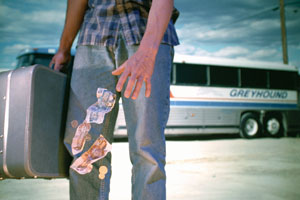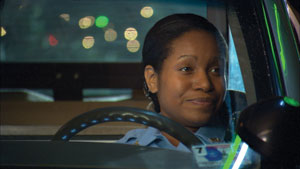A young man in Teresa Hubbard and Alexander Birchler’s docu-video Grand Paris Texas, part of No Room to Answer at the Modern Art Museum of Fort Worth, explains the difference between films and movies. In a commentary on Wim Wenders’ Paris, Texas (1984), this native of the town of Paris, Texas sincerely tells the camera that films are meaningful in a life transforming way, while movies are just a way to pass time. Simply put, films are art while movies are spectacle.
As with everything by Hubbard and Birchler, Grand Paris Texas is no simple matter. Commissioned by the Modern Art Museum of Fort Worth, Grand Paris Texas is a 54-minute moving image piece that, medium-wise, falls somewhere between film, documentary and video. Much like the other moving-image works by the two Austin-based artists, it is movie-like only insomuch as it is polished and seamless like a Hollywood production. Mirroring the profound circuitousness of Wenders’ film (the focus of which wasn’t really Paris, Texas), the substance of Grand Paris Texas is less about Wenders than it is about the town theater, the abandoned downtown big-screen house called The Grand. Hubbard and Birchler’s Grand Paris Texas deals, at least on the face of things, with the decline of cinema as a public art form rooted in and promoting in-town collectivity. Today we watch movies, not always films, in the comfort of our single-family dwelling within an atomized urban context, not downtown on Main Street in the old movie house. Yet, like Wenders’ work, Grand Paris Texas maneuvers between the aesthetic realm of the still image and the diegetic space of linear story telling. And that’s why the young man’s succinct commentary on film versus movies is important here: it announces the thoughtful and layered inbetween-ness of the work of Hubbard and Birchler.
Hubbard and Birchler’s work, moving- and still-image alike, couples the smooth editing of big-budget Hollywood filmmaking with the absurdity of visual non-sequiturs common to the most interesting modern and contemporary art. While their work braids varying aesthetic strands, it is the provocative though subtle infusion of Hollywood into art that makes them singular – different from most moving-image artists and photo-conceptualists. Their work falls into the camp of the Cremaster Cycle and Drawing Restraint series, aligning itself with Matthew Barney’s penchant to fuse high dollar Hollywood filmic production, surreal objects and haute couture designs, or what Barney once called “narrative sculpture.” Also brought to mind is the TV- and movie-based work of Karina Nimmerfall, the young German video and installation artist who reinterprets establishing shots by way of video projection and architectural vignettes. Similarly within the realm of the cinematically constructed moment, Hubbard and Birchler’s photographs are “made” like Jeff Wall and Gregory Crewdson’s. That is, they are fabricated set-ups that are then photographed, something like crafted and built architectural sections, renderings that get extruded into three dimensions only to be made flat again in the photographic image.
Hubbard and Birchler have mined and dissected the moving-image work in the broadest sense of the term (from film to video) in order to extract new elements for art making. Take for example the circular pan and loop, two tropes that might otherwise get lost in the organic totality of film and videos. Just as Pollock deployed surrealist chance in new ways with the deployment of the drip, Hubbard and Birchler pull both out and tweak them to magnificent effect. In the 6-minute 7-second Single Wide, viewers find a woman and a manufactured home. The camera pans around and around showing a woman in a pick-up truck. She pulls in and pulls out, depending on where you are in the loop. We see her leaving and returning, with a bag of toys in hand. Meanwhile, the camera pans around the single-wide manufactured home, one half of which has been sliced open in order to reveal the inside as though an architectural drawing of a section. We see a dollhouse, stuffed animals and a single bed in a child’s room, then the living room, kitchen, a bathroom, then an adult’s bedroom. Woman leaves in truck. Phone rings. Camera pans around. Woman returns, pulls up and screams. She takes a moment and then crashes into the manufactured home, making mayhem out of the structure and the living area inside. She struggles out of the car, sits down, looks at the scratch on her head, and the loop seamlessly begins again. The action of narrative’s image-after-image movement collides into the stillness of the single shot.
There are several series of large scale C-prints (roughly 5×6 feet) that further unpack the artists’ fascination with the tension between the single, still photographic image and the multiple, moving pictures of the filmic story. An ongoing project, Filmstills offers a face-off between yesterday’s tumbledown single or double theater cinema-tech and today’s multi-storied ten- or twelve-screen multiplex. Like Cindy Sherman’s stills, these are false stills: photographic images of old and new movie theaters that have been constructed by the artists. Unlike Sherman’s use of characters, Hubbard and Birchler’s theater images have no people in them. They are composite images, literally concocted from several different shots of theater facades taken at different moments. As with Grand Paris Texas, the artists comment on the role that movies and movie houses have played in the construction of our vision – the way we understand movies and, more importantly, how we take in knowledge through images. An extended and more philosophically complex commentary on the work of Wim Wenders, in particular the 1975 film Kings of the Road about a projection operator roving across Germany to repair and operate machines in old movie theaters, is also at work here.
The work of Hubbard and Birchler calls for the rumination that painting once required and engrossing cinema demands. Curator Andrea Karnes has done an excellent job with No Room To Answer. On occasion the portraiture-like photographs of actors accompanying the moving-image pieces may seem like overkill. They may seem to let the miraculous and magical cat out of the bag in their unveiling of the machinations behind the work. At the same time, though, these photographs bring home the two-part theme of Hubbard and Birchler’s work: first, our vision – our epistemology for that matter – has and continues to be formed by the moving-image industry; and second, within that matrix and in the hands of deft and acute talent, image can be teased from story making for striking, memorable and beautiful experiences.
Hubbard/Birchler: No Room To Answer
September 14, 2008 – January 4, 2009
Modern Art Museum of Fort Worth
Charissa N. Terranova is the Assistant Professor of Aesthetic Studies
at UTD and the director of Centraltrak, the UTD Artists Residency Program.
Also by Charissa N. Terranova
{ Review }
"Sehnsucht (Aspiration)" at Light & Sie
{ Feature }
Punkish and Puckish: An Interview with Tim Noble and Sue Webster
{ Feature }
Arthouse Renovation
{ Feature }
Becoming-Animal: Rebecca Carter, A Hybrid Approach to Art as Life
{ Interview }
Tracey Emin is a woman’s woman
Image credit:
Teresa Hubbard / Alexander Birchler
Grand Paris Texas, 2008
High-definition video with sound
Installation dimensions variable
Commissioned by the Modern Art Museum of Fort Worth
Teresa Hubbard / Alexander Birchler
Falling Down, 1996
8 C-Print Photographs, each 80 x 120 cm
©Courtesy the Artists and Tanya Bonakdar Gallery, New York
Teresa Hubbard / Alexander Birchler
Night Shift, 2005 High Definition Video with
sound transferred to DVD
4 channel monitor installation
Duration: each monitor 2 min 10 secs, loop
Installation dimensions variable
©Teresa Hubbard / Alexander Birchler
Originally Commissioned by Art21, NY









